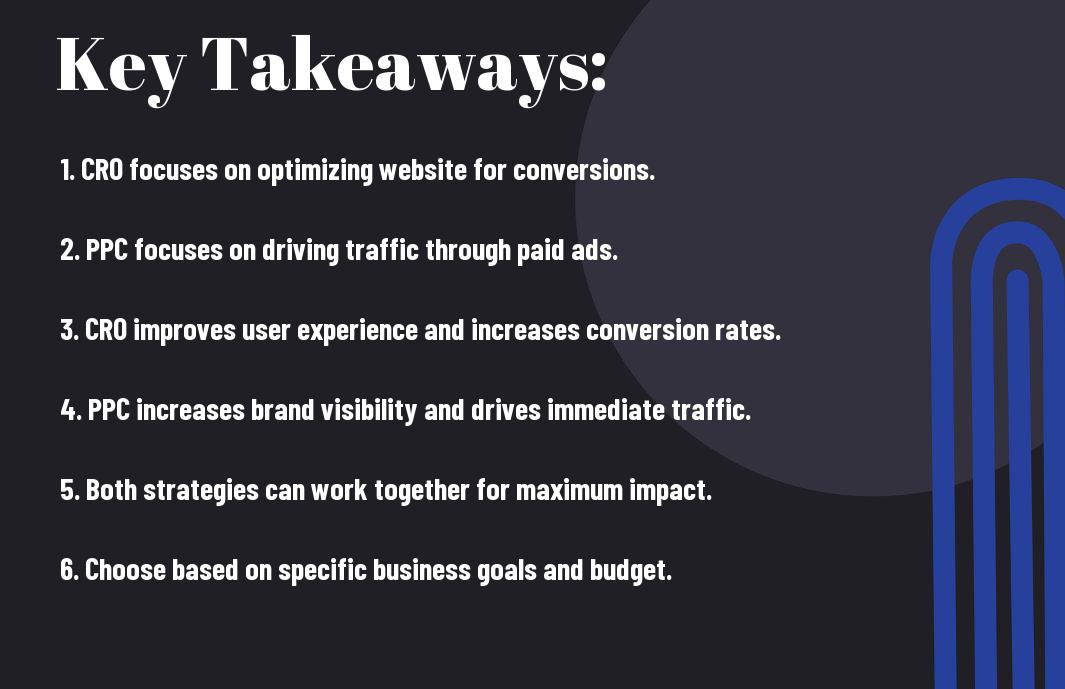Embroiled in the world of digital marketing, you may have encountered the terms Conversion Rate Optimization (CRO) and Pay-Per-Click (PPC) advertising. But which one is truly the best fit for your business? Understanding the differences and benefits of each will help you make an informed decision that can ultimately impact the success of your marketing efforts. CRO focuses on optimizing your website to increase the percentage of visitors who take a desired action, while PPC involves paying for each click on your advertisement. It’s essential to consider your specific goals, budget, and target audience when determining which strategy will yield the best results for your business. Let’s delve deeper into the intricacies of CRO and PPC to help you make a sound decision.
Key Takeaways:
- CRO focuses on increasing conversion rates – CRO, or conversion rate optimization, is targeted at improving the percentage of website visitors who take a desired action, such as making a purchase or filling out a contact form.
- PPC is geared towards driving website traffic – PPC, or pay-per-click advertising, is designed to generate website visits by placing ads on search engine results pages and other online platforms.
- CRO can provide long-term benefits – By optimizing your website for conversions, you can create a better user experience and increase the likelihood of repeat business, leading to sustained growth over time.
- PPC can deliver quick results – With PPC, you can see immediate increases in website traffic and potential leads, making it an effective short-term strategy for boosting your business.
- The best approach depends on your business goals – Ultimately, the decision between CRO and PPC should be based on your specific objectives, budget, and timeline, as well as the nature of your industry and target audience.

Understanding CRO (Conversion Rate Optimization)
Some businesses focus solely on driving traffic to their website through PPC (Pay-Per-Click) advertising, but if you want to maximize the return on your investment, you need to pay attention to CRO (Conversion Rate Optimization) as well. By understanding and utilizing CRO strategies, you can ensure that the traffic you are getting actually converts into paying customers.
What is CRO?
CRO, or Conversion Rate Optimization, is the process of enhancing your website or landing page to increase the likelihood that visitors will take a desired action, such as making a purchase, signing up for a newsletter, or requesting more information. This involves analyzing data, making improvements to your website, and conducting experiments to determine which changes lead to higher conversion rates.
Benefits of Investing in CRO
Investing in CRO has numerous benefits for your business. By optimizing your website for conversions, you can improve the overall user experience, increase your sales and revenue, and ultimately, get more out of the traffic you are already receiving. Additionally, improving your conversion rate can have a significant impact on your bottom line without requiring additional advertising spending.
Insights into PPC (Pay-Per-Click Advertising)
Keep in mind that PPC advertising is a popular online marketing strategy where advertisers pay a fee each time their ad is clicked. It’s a way of buying visits to your site, rather than attempting to “earn” those visits organically. Every time your ad is clicked, sending a visitor to your website, you have to pay the search engine a small fee. When PPC is working correctly, the fee is trivial, because the visit is worth more than what you pay for it. In other words, if you pay $3 for a click, but the click results in a $300 sale, then you’ve made a hefty profit.
Explanation of PPC
With PPC, you bid on the keywords you want your ads to show up for in search results. When someone searches for those keywords, your ad could show up. The position of your ad is determined by your ad’s relevance and the amount you are willing to pay for a click. The higher your bid and the more relevant your ad, the more likely it is to appear at the top of the search results.
Advantages of Utilizing PPC
The biggest advantage of utilizing PPC is the immediate results it can provide. Unlike other forms of advertising, with PPC you can start seeing results almost immediately. Furthermore, with PPC, you have complete control over your budget and can set a maximum amount you are willing to spend each day. PPC also allows you to target specific audiences and track the performance of your ads in real-time, allowing you to make adjustments as needed to maximize your ROI.
Comparative Analysis
Now, let’s delve into a comparative analysis of CRO and PPC to help you understand their differences and how they can impact your business. If you’re looking for more in-depth information on the topic, you can check out this PPC or CRO Management?
CRO vs. PPC
| CRO (Conversion Rate Optimization) | PPC (Pay-Per-Click Advertising) |
| Focuses on optimizing your website to increase conversion rates. | Drives traffic to your website through paid advertisements. |
| Helps improve user experience and engagement on your site. | Targets specific keywords and demographics to reach potential customers. |
| Requires continuous testing and iterations to enhance performance. | Immediate results can be achieved with the right strategy. |
Cost Implications and ROI
When it comes to the cost implications and ROI, it’s important to carefully consider your budget and the potential return on investment for both CRO and PPC. While CRO may require ongoing investments in testing and optimization, the long-term impact on your bottom line can be significant. On the other hand, PPC can provide immediate results, but you need to keep investing in ad spend to maintain traffic and conversions.
Long-Term vs. Short-Term Effects
Considering the long-term vs. short-term effects, CRO focuses on making sustainable improvements to your website that can benefit your business over time. This means that the positive impact of CRO efforts can compound and deliver consistent results. In contrast, PPC can deliver quick wins and immediate traffic, but it’s essential to continuously monitor and optimize your campaigns to sustain the results.

Strategic Implementation
Unlike traditional marketing strategies, both CRO and PPC require a strategic and data-driven approach for their implementation. Your business needs to have a clear understanding of your audience, their preferences, and their behavior to effectively implement both strategies. It’s important to consider the overall marketing goals and objectives of your business while deciding which approach to focus on. For more insights on this, you can read an in-depth analysis on Email CRO or PPC? Which Is More Important to Focus on.
Integrating CRO and PPC into Your Business
When it comes to integrating CRO and PPC into your business, it’s important to align both strategies with your overall marketing plan. You can leverage the data and insights from your PPC campaigns to optimize your landing pages and conversion funnels for better results. By integrating the two, you create a synergy that boosts the overall performance of your marketing efforts, resulting in better conversion rates and ROI.
Best Practices for Maximizing Results
One of the best practices for maximizing results with CRO and PPC is to continuously test and optimize your campaigns. This includes A/B testing your ad copies, landing pages, and calls-to-action to identify the most effective combinations. Additionally, focusing on high-converting keywords and continuously refining your targeting will help you maximize the impact of your PPC campaigns. By staying updated with the latest trends and best practices, you can stay ahead of the competition and achieve better results for your business.
Conclusion
Taking this into account, it is clear that both CRO and PPC have their own unique benefits for your business. While PPC can help drive immediate traffic and leads to your website, CRO focuses on optimizing the user experience to increase conversions. Ultimately, the decision on which is better for your business depends on your specific goals and needs. If you are looking for quick results and are willing to invest in advertising, PPC may be the better option for you. On the other hand, if you are more focused on improving your website’s performance and maximizing your return on investment, CRO is likely the better choice. Whichever route you choose, it’s important to carefully consider your business objectives and align your digital marketing strategy accordingly.
CRO vs. PPC – Which Is Better for Your Business?
Q: What is the difference between CRO and PPC?
A: CRO (Conversion Rate Optimization) focuses on improving the conversion rate of your website, while PPC (Pay-Per-Click) is a method of online advertising where you pay for each click on your ad.
Q: How does CRO benefit my business?
A: CRO helps to maximize the value of your existing traffic by improving the user experience and increasing the likelihood of conversion. It focuses on making your website more effective in turning visitors into customers.
Q: How does PPC benefit my business?
A: PPC allows you to quickly reach a targeted audience and drive traffic to your website. It can also provide valuable data on keywords and customer behavior, and offers the potential for immediate results and a high ROI.
Q: Which is better for long-term growth – CRO or PPC?
A: CRO focuses on improving your website’s performance, which can have lasting effects on your business. While PPC can provide immediate results, CRO is essential for sustained growth and long-term success.
Q: Can CRO and PPC work together for my business?
A: Absolutely. CRO and PPC can complement each other by optimizing your website for conversions and driving targeted traffic through paid ads. By combining the two, you can maximize the effectiveness of your online marketing efforts.
